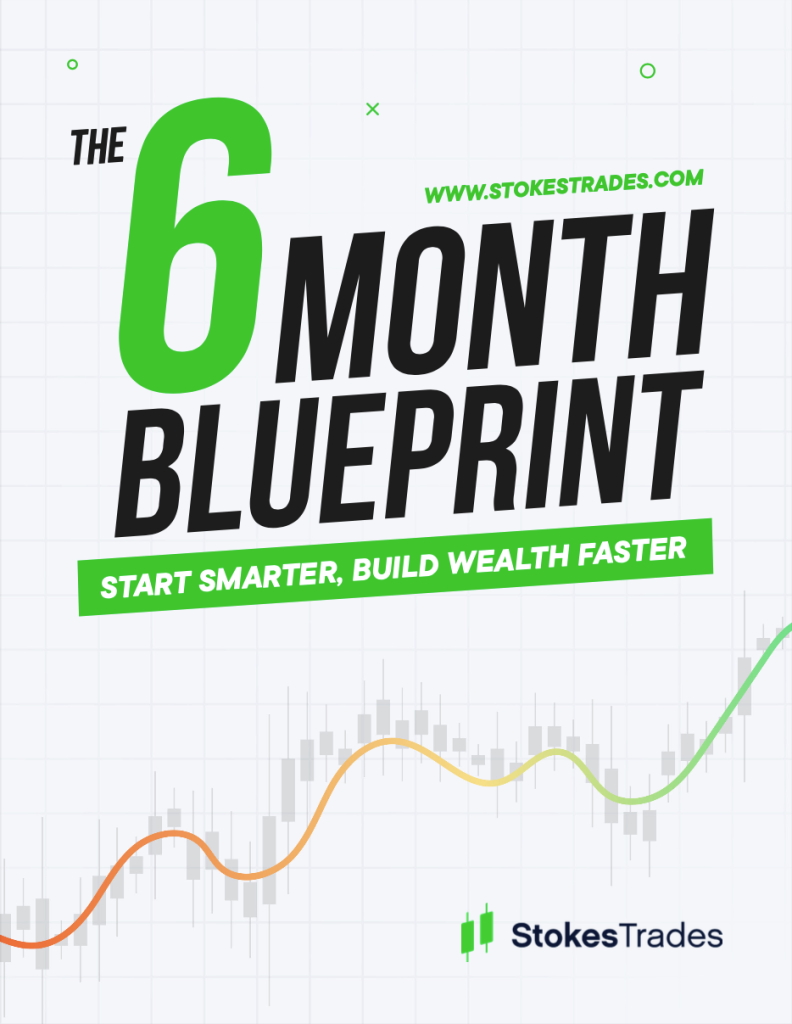If you’re like I was two years ago—excited about trading but overwhelmed by the endless options—you’re in the right place.
I’ve spent nearly two years diving deep into the markets, starting with the hype of day trading and evolving into a low-stress momentum strategy that’s grown my portfolio by over 144% in my first 6 months of real-money trading (starting April 2025).
In this article we’re zooming out for the big picture on becoming a trader. I’ll break down the two main approaches I discovered after trial and error, share my story, and show you how focusing on a single strategy—like my updated Momentum Trading Blueprint—can get you trading confidently in weeks, not years.
Whether you’re a busy parent, full-time worker, or just someone who a better ROI, this is your roadmap to smarter, faster progress.
Trading involves risks, and results aren’t guaranteed. But by the end, you’ll see how to avoid my early frustrations and build real skills.

Download the Blueprint on Skool
If you don’t have a copy yet, consider downloading my free 6 Month Blueprint. Find Blueprints and free courses in our Skool Community
My Journey: From Overwhelmed Beginner to Momentum Master
When I kicked off in January 2024, I fell for the day trading myth: quick wins, non-stop action, staring at charts during market hours. I studied everything—stocks, futures, forex—set up an Interactive Brokers account (thinking I’d day trade), and built a broad base in technical analysis. We’re talking Elliott Wave theory, MACD, RSI, trend lines, market structure, support and resistance, and more. It felt productive, but it was scattered.
Then I had a reality check:
With my family, work, and limited screen time, day trading was a burnout waiting to happen. I pivoted to momentum trading—a position-style approach where you ride upward trends for weeks or months. It’s less stressful, fits real life, and focuses on high-probability setups without constant monitoring.
This shift was a game-changer. Like many beginners, I learned that your trading style depends on how much time you can commit to the markets. If you’re juggling a full-time job, day trading’s intense demands are nearly impossible to sustain. Even swing trading requires a couple of quiet hours each market day to analyze charts and make decisions. But if you’re like me—balancing family, kids, or a busy schedule—position trading, with just an hour or two on weekends or evenings, offers a longer-term view, more flexibility for trades to play out, and less stress from daily market noise.
Most new traders, myself included, are drawn to the idea that trading more frequently equals bigger profits. That’s a trap. Position trading often delivers better results for beginners, with fewer mistakes and less emotional strain. While many lose money day trading due to its steep learning curve and time demands, position trading’s slower pace makes it easier to achieve consistent gains early on.
The Two Paths to Becoming a Trader: Which One Fits You?
After years of experimenting, I boiled it down to two ways to learn trading. Both work, but one can save you months or years of frustration. Think of them as forks in the road: one explores the whole map first, the other picks a destination and charts the direct route.
Path 1: Build a Broad Base of Knowledge, Then Find a Strategy (The “Explorer” Approach)
This is how most beginners start—like I did. It’s thorough but can feel like wandering in the dark.

- Step 1: Study the Markets Broadly. Dive into stocks, futures, forex, options—understand the basics of each. Why? To avoid jumping into something that doesn’t suit you.
- Step 2: Set Up Your Foundation. Open a brokerage account (e.g., Interactive Brokers for features, Robinhood for simplicity). Learn core technical analysis: trend lines, support/resistance, indicators like MACD/RSI, market structure, Elliott Wave theory and so on. This gives you a “big picture” toolkit.
- Step 3: Test and Refine (The Long Road to Clarity). Now comes the reality check: testing trading styles like scalping, day trading, or swing trading through paper trading can take a long time—months or even years. You’ll need to experiment with each approach, tweaking setups, analyzing results, and reflecting on what clicks with your schedule and personality. For example, if you’re juggling a day job or family, day trading’s high-intensity pace might feel like a treadmill set to sprint. This phase is a grind because you’re not just testing strategies—you’re sifting through an avalanche of information. Studying multiple approaches (scalping’s quick hits, swing trading’s multi-day holds, position trading’s longer horizons) can be overwhelming, especially when you’re learning new indicators, chart patterns, or market nuances for each. It’s easy to get lost in the noise, second-guessing what works or chasing the next shiny strategy. Worse, the trading world is a minefield of low-quality groups and courses. As you explore communities you’ll stumble into spammy forums, hyped-up “gurus,” and overpriced courses promising overnight riches. These can derail your focus, drain your wallet, and leave you more confused than when you started.
How to Navigate: Be patient and selective. Paper trade each style for weeks (or months) to see what fits—use a simulator like TradingView or your broker’s platform to keep it risk-free. Join reputable communities if you can find them. Take notes on what aligns with your life (the more available time you have, the lower the timeframe you can trade). Keep in mind this doesn’t mean you should day trade just because you have a lot of free time – it’s just a requirement. This trial-and-error will eventually reveal your sweet spot, but brace for a marathon, not a sprint. My own pivot to momentum trading took about a year of studying—time I could’ve saved with a clearer path.
Pros: Comprehensive knowledge makes you versatile. You won’t feel “behind” on basics.
Cons: Time sink—months of study before real trades. Easy to get overwhelmed or chase shiny objects (e.g., learning futures when stocks suffice).
This path suits curious learners who want to master the “why” behind markets. But if you’re eager to trade sooner, it might frustrate you.
Path 2: Pick a Strategy First, Then Cherry-Pick What You Need (The “Direct” Approach)
This is my “if I could start over” method—and it’s way faster. Instead of broad study, choose a strategy upfront, learn only its essentials, and hit the ground running. For busy folks, this means weeks to first trades, not years.

- Step 1: Evaluate Strategies Based on Your Life. Ask: How much time do I have? (Day job + family = no to day trading.) What appeals? (Quick scalps? Steady momentum?) Review options that you find a research. See if something aligns with your personality.
- Step 2: Learn Just Enough. Focus on strategy-specific tools. No need for forex/options/futures if your pick is stocks. Cherry-pick TA: support/resistance, key indicators. Skip the rest to avoid overload.
- Step 3: Practice and Go Live Quickly. Paper trade the strategy for confidence, then start small with real money. Build from there—journal, review, scale.
Pros: Accelerated progress—trade in weeks. Less stress, targeted learning. My momentum pivot proved it: I had a 84% gain in my portfolio in just 5 months without daily noise.
Cons: Less breadth of knowledge. If the strategy doesn’t click, you might need to switch (but that’s easier with basics in hand).
This path flips the script: Strategy first, knowledge second.
It’s ideal if you want results fast and hate trial-and-error. (Pro tip: Our Skool community and Momentum Trading Kickstart course make this plug-and-play—no guessing required.)
Spotlight: My Updated 6-Month Momentum Trading Blueprint – The Faster Path in Action
To make Path 2 concrete, here’s my refined blueprint.
It’s designed for 30 minutes a day, focusing on riding upward momentum in stocks. No hype—just a simple, low-stress way to build wealth.
Why Momentum Trading? A Quick Explainer
Momentum trading identifies stocks already climbing (higher highs/lows on daily/weekly charts) and joins at “support zones” (price floors where buyers step in). Buy low-risk, hold for weeks/months, exit when momentum fades. It’s safer than day trading—no burnout, fits busy schedules. Tools like the Ichimoku Cloud, moving averages (50/100/200-period), Fibonacci retracements, and Gann Squares confirm entries. Start small (1-3% portfolio), add on pullbacks (up to 10% max per stock), and scale out profits. My results? Steady gains without FOMO or overtrading.
The 6-Month Blueprint: Start Smarter, Scale Faster
Condensed for action—focus on must-dos, ignore the noise.
Month 1: Foundation Building
- Learn momentum basics: Uptrends, support/resistance, why it beats day trading.
- Set up: Broker (Thinkorswim/IBKR/Robinhood), TradingView for charts, paper trading simulator.
Months 1-2: Gear Up
- Master tools: TradingView is your only charting need. Practice using it risk-free. Sign up here.
Months 2-3: Spot Opportunities
- Key TA: Market structure (higher highs/lows), support buys, indicators (The Ichimoku Cloud, MAs, Fib, Gann). Avoid downtrends/resistance.
Months 3-4: Execute with Rules
Follow these 5 core rules to stay disciplined:
- Stick to the Strategy: Paper trade until it’s habit; review daily.
- Never Chase Price: Wait for support pullbacks—skip if not there.
- Limit Position Size: 1-3% entry, max 10% total per stock; scale in gradually.
- Buy at Support, Sell at Resistance: Use confluence for confirmation; partial sells on fades.
- Stay Uncomfortable: Buy on red days—great entries often feel off. Embrace it.
Months 4-5: Build Mindset
- Avoid traps: FOMO, overtrading, plan abandonment.
- Habits: Daily journal (trades/emotions), 30-min routine. Learn from losses—mine taught patience.
Months 5-6: Review and Go Live
- Timeline: Months 1-2 practice, 3-4 simulate, 5 real money (small), 6 scale/review.
- Only go live when paper trading succeeds.
This blueprint is lean by design—master one strategy, trade faster. No detours into unrelated markets. Download the actual Blueprint here.
Wrapping It Up: Your Next Step to Trading Success
The big picture?
Learning how to trade isn’t one-size-fits-all.
Path 1 builds a wide base before strategy hunting—great for explorers, but slow and overwhelming.
Path 2 jumps to a strategy (like momentum) and cherry-picks knowledge—faster, focused, profitable sooner. Both lead to wins, but if you’re busy like me, go direct: Review strategies, test one, learn what matters.
Want guided steps?
Join the free Skool community for the Momentum Trading Kickstart course—video lessons, support, and my latest gains. Avoid my years of wandering. Start building wealth now.


